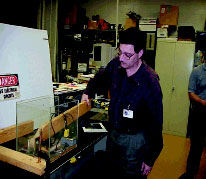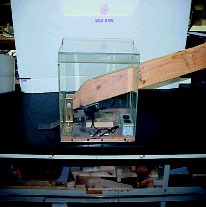According to the U.S. Consumer Product Safety Commission (CPSC), residential electrical equipment is involved in approximately 150,000 fires each year in the United States, which result in 850 deaths, 6,000 injuries, and more than $1.5 billion in property losses. A new technology called “arc-fault detection” has been developed to reduce this problem. Research conducted by UL has shown “arc-fault detection” to be a promising technology for further reducing the risk of fire beyond the scope of conventional fuses and circuit breakers that protect branch circuits. Using this new technology may save many lives and dramatically reduce the property damage and injuries caused each year by electrical fires.
In 1995, UL completed a research project for the CPSC and issued a report titled, “Technology for Detecting and Monitoring Conditions That Could Cause Electrical Wiring System Fires.” A number of technologies were identified and explored in the report, and although there was no single technology found that would protect against all electrical ignition scenarios likely to be encountered in residential wiring systems, arc-fault detection was identified as an effective means of reducing fires due to electrical arcing.
What is “arc heating?”
An electrically caused fire can occur if electrical energy is converted to thermal energy and the heat generated is transferred to a combustible material at a rate that will cause the material to reach its ignition temperature. One mechanism involved in converting electrical energy to thermal energy in an electrical distribution system is arc heating.
“Arcing” is defined as a luminous discharge of electricity across an insulating medium. The electrical discharge of an arc can involve temperatures of several thousand degrees Celsius. In determining the heating effects of an arc, the classical Joule heating equation involving current squared multiplied by resistance (I2R), however, does not fully explain the heating effects. Although the total power dissipated in the arc is equal to the total voltage drop in the arc multiplied by the arc current, power dissipation is not uniform throughout the arc.
In general, arcing can be divided into two categories: (1) non-contact arcing and (2) contact arcing.
“Non-contact arcing” is arcing that does not require direct physical contact between the conductors or “electrodes” where the arcing is taking place. Two types of non-contact arcing involving lower voltages are: a) arcing between conductors separated by insulation that occurs across the surface of the insulation, and b) arcing between conductors separated by pyrolyzed (carbonized) insulation.
With arcing between conductors separated by insulation, the mechanism of initiating an arc between stationary conductors separated by insulation will depend on the type and geometry of the conductors and insulation between them. In the case of typical air clearances found in an electrical residential distribution system, many kilovolts may be required to initiate arcing.
With arcing between conductors separated by carbonized insulation, arcing can occur at normal operational voltages. The resulting fault-current causes the carbon path to open and an arc is established similar to parting the conductors, as with contact arcing. Carbonized insulation between opposite polarity conductors or between a line-voltage conductor and ground can lead to an across-the-line arcing fault or a line-to-ground arcing fault.

Photo 1. This “guillotine” type tester simulates an unprotected metal chair or table leg penetrating through an extension cord for the Point Contact Arc Test
“Contact arcing” is arcing that involves direct or indirect physical contact between the conductors, known as electrodes, where the arcing is taking place, such as arcing between closing or parting conductors making or breaking a circuit. With this type of arcing, the arc initiation mechanism involves a hot point (essentially from I2R heating) at the last point of contact when a circuit is being interrupted (i.e., conductors initially in contact are parting), or at the first point of contact where a circuit is being established (i.e., conductors that are initially separated and subsequently come into contact).
Contact arcing is associated with normal operational arcing that occurs with any kind of air-gap type electrical switching device. Properly designed switching devices are capable of withstanding such arcing without excessive contact damage or generation of excessive heat. Contact arcing may also be associated with arcing faults due to the unintentional creation or interruption of current.
Technology for the 20th century—overcurrent protective devices
An overcurrent protective device (OCPD), such as a fuse or circuit breaker, is specifically designed to protect elec-trical circuits against the unwanted effects of over-currents. For example, when too many products are plugged into the same electrical outlet, and the total load current exceeds the rating of the branch circuit, the OCPD will open the circuit before damage or a fire occurs. An OCPD, however, is not designed to protect a circuit against arcing faults. Because of the time-current characteristics of the OCPD necessary to provide effective protection against overcurrents, some arcing faults, including damaging arcing faults, may have time and/or current characteristics below the threshold levels necessary to open the OCPD.
The AFCI—technology for the 21st century

Photo 2. This “guillotine” type tester simulates an unprotected metal chair or table leg penetrating through an extension cord for the Point Contact Arc Test
To offer additional protection to electrical circuits against the unwanted effects of electrical arcing, manufacturers have begun incorporating arc-fault detection technology into a product known as an Arc-Fault Circuit Interrupter, or AFCI. An AFCI is a device intended to reduce the number of arcing-fault fires by opening the electrical circuit when an arc fault is detected. What differentiates an AFCI from an OCPD is the complex electronic circuitry in the AFCI that can identify specific characteristics or signatures of the current or voltage waveform that are unique to electrical arcing.
Setting the standard for AFCIs
In conjunction with the National Electrical Manufacturers Association (NEMA), UL began working with manufacturers and other interested parties in 1998 to form an Industry Advisory Group (IAG), to develop a Standard for Safety for AFCI products. In February 1999, UL published the First Edition of the Standard for Safety for Arc-Fault Circuit Interrupters (UL 1699). In this UL Standard, five different types of AFCI products are described as follows:
- Branch/Feeder AFCI– A device installed at the origin of a branch circuit or feeder, such as at a panelboard, to provide protection of the branch circuit wiring, feeder wiring, or both, against unwanted effects of arcing. This device also provides limited protection to branch-circuit extension wiring. It may be a circuit-breaker type device or a device in its own enclosure mounted at or near a panelboard.
- Outlet Circuit AFCI– A device installed at a branch circuit outlet, such as at an outlet box, to provide protection of cord sets and power-supply cords connected to it (when provided with receptacle outlets) against the unwanted effects of arcing. This device may provide feed-through protection of the cord sets and power-supply cords connected to downstream receptacles.
- Combination AFCI– An AFCI which complies with the requirements for both branch/feeder and outlet circuit AFCIs. It is intended to protect downstream branch-circuit wiring, cord sets and power-supply cords.
- Portable AFCI– A plug-in device intended to be connected to a receptacle outlet and provided with one or more outlets. It is intended to provide protection to connected cord sets and power-supply cords against the unwanted effects of arcing.
- Cord AFCI– A plug-in device connected to a receptacle outlet, to provide protection to the power-supply cord connected to it against the unwanted effects of arcing. The cord may be part of the device. The device has no additional outlets.
In addition to specific construction requirements, UL 1699 also incorporates extensive test requirements to determine that AFCI devices are: 1) effective in preventing fires due to arcing faults, 2) not subject to unwanted (nuisance) operation, and 3) not inhibited from operation by other loads or circuit characteristics that could mask or attenuate the unique properties of an arc signature. The AFCI must also pass rigorous tests that address environmental conditioning, overloads, endurance, short-circuits, voltage surge and other abnormal conditions.
Putting AFCIs to the test

Photo 3. A 12-amp vacuum cleaner with brush contacts on a universal motor is one of the loading conditions used to demonstrate resistance to unwanted operation of the AFCI
Tests that demonstrate the effectiveness of an AFCI in detecting and protecting against arcing are unique, and were developed specifically for UL 1699. All AFCIs must pass a point-contact arc test with either SPT-2 cord and/or NM-B cable. Point-contact arcing is a type of contact arcing that can occur when a sharp object cuts through parallel wires, first contacting one conductor, and then arcing when contact is made with the other conductor. For example, point-contact arcing can occur when an unprotected metal chair or table leg rests on an extension cord or appliance supply cord, and gradually or suddenly penetrates through the conductor insulation, contacting both conductors. In this case, a fire can result from ignition of the conductor insulation, or the ignition of other materials in the immediate area. An AFCI must detect point-contact arcing in circuits with available current as low as 75A, and operate to open the circuit within eight half-cycles of arcing current.
Additional arc-fault detection tests, depending upon the type of AFCI involved, include carbonized-path arc ignition, arc interruption and arc-clearing-time tests. These tests are designed to demonstrate the ability of the AFCI to detect non-contact arcing, such as arcing that can occur if electrical insulation breaks down.
When AFCIs should—and should not— operate
AFCIs respond to a specific characteristic or signature of the current waveform associated with an arcing fault. These characteristics can be a combination of the presence or absence of certain frequencies, the duration of those frequencies, the rate of rise of electrical current, and similar phenomenon. To avoid unwanted or nuisance operation, AFCIs must distinguish between an arc-fault current waveform signature and current waveforms representing a variety of normal loading conditions. The loading conditions to demonstrate resistance to unwanted operation in UL 1699 include:
- inrush currents, such as tungsten lamps and motor starting;
- normal operation arcing, such as switch or thermostat operation, and brush contact on universal motors;
- non-sinusoidal waveforms, such as those associated with electronic dimmers and computer power supplies; and
- light bulb burnouts.
Operation inhibition tests in UL 1699 are intended to address a number of situations that could inhibit an AFCI from operating when actual arcing is occurring. These conditions range from the use of electromagnetic interference (EMI) filters, which could attenuate high frequency arc-fault signatures, to circuit impedance characteristics that may be inherent to different types of wiring systems used in older and newer homes.
AFCIs and the NEC
The 1999 National Electrical Code (NEC) includes a new Section 210-12 that requires all branch circuits that supply 125-volt, single-phase, 15- and 20-ampere receptacle outlets installed in dwelling unit bedrooms to be protected by an AFCI. This requirement is scheduled to take effect January 1, 2002. The introduction of AFCIs into the NEC for bedroom outlet circuits was based on permitting these devices to be introduced to the public on a gradual basis. However, this does not prohibit the use of AFCIs in other circuits or rooms throughout the home.
Toward a safer future
Manufacturers have already begun to seek UL Listing of their AFCI products to UL 1699, and interest in these products is expected to increase significantly as contractors, electricians and consumers become more aware of their availability and intended application. In the next century, the benefit from the use of AFCIs should be significant, not only in terms of property losses and injuries caused by electrical fires each year, but also in the saving of many lives.














Find Us on Socials